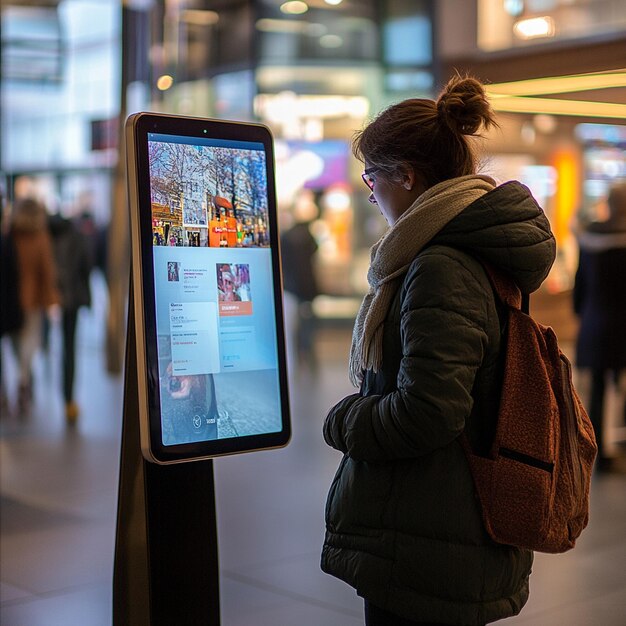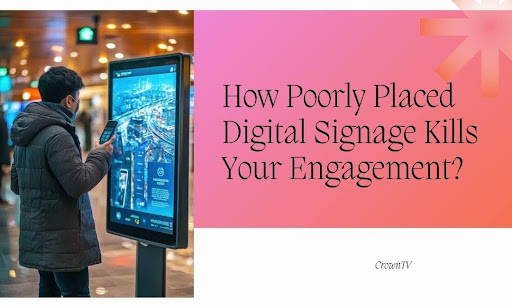A screen can be stunning. The content can be flawless. The timing can be spot on. But what if your digital signage is in the wrong spot? It might as well be turned off. Here’s the thing — placement isn’t decorative. It’s functional. When screens don’t hit the right sightlines or compete with environmental distractions, they stop pulling people in. And that kills engagement.
According to a study, digital signage captures 400% more views than static displays — but only when people can actually see them. Once a screen falls into a dead zone, you don’t just lose eyeballs. You lose conversions, impressions, and dollars.
You’re in the right place if you’re asking:
“Why isn’t my signage performing the way it should?”
This article breaks down exactly what’s going wrong — and how to fix it.
Here’s what we’re getting into:
- What dead zones are and how they silently kill your engagement
- Why screen placement matters more than you might think
- Quick signs your current setup might be failing you
- How to reposition your screens to get eyes — and results
- A smarter way to test screen performance (without wasting time)
- How businesses are using CrownTV’s dashboard and plug-and-play tools to cut down screen dead zones and boost engagement
By the end, you’ll know how to spot a dead zone, fix it fast, and pull more people into your content without changing a single asset.
The Silent Killers Hiding Behind Your Screens
Dead zones don’t always look like a problem. The screen is powered on. The content plays without a hitch. But no one’s watching — or worse, no one’s even noticing it.
That’s a dead zone. A dead zone is any spot where your signage fades into the background. It’s where content gets buried by poor placement, clunky angles, or visual competition. From the outside, everything seems fine. Internally? Engagement tanks. Dead zones pop up more often than you’d expect.
A few common causes:
- Screens mounted too high or too low for natural sightlines
- Placement behind glass, pillars, or obstructions
- Competing visuals pulling attention away (like bright lighting or busy walls)
- Poor screen orientation in high-traffic areas where people move fast
- Awkward corners or dead ends that rarely get foot traffic
When screens fall into these traps, attention drops — and so does ROI. People stop looking, which means they stop engaging, clicking, or buying. And because most content strategies focus on what goes on the screen, not where the screen lives, these issues can go undetected for months. Sometimes years. And here’s where it gets interesting. The rise of digital devices in public spaces has followed the same curve as issues flagged in the diagnostic and statistical manual — particularly concerns around attention deficit hyperactivity disorder, technology addiction, and overstimulation caused by constant screen exposure.
In high-traffic environments — especially those with widespread internet access and passive exposure to social media platforms — people mentally tune out anything that doesn’t break through the noise. That includes your signage.
There’s an overlap between what we understand about mental health, digital overstimulation, and how people engage with public content. Poor placement doesn’t just miss the mark — it adds to the noise. And in environments already shaped by internet addiction and short attention spans, that’s a recipe for failure. Even well-produced content can’t fight poor placement. If the screen doesn’t sit where the eyes naturally go, people walk past it. Or worse — they don’t even realize it’s there. So, the first step? Spot the dead zones. Call them out. Because fixing them starts with seeing them.
Why Screen Placement Drives Results More Than You Expect

Content doesn’t get attention on its own. Placement either sets it up for success or buries it in plain sight. Let’s get one thing straight — people aren’t walking around searching for screens. Their eyes are already busy. Your signage has to cut through that noise and pull attention in the split-second window when someone walks by. And that window is smaller than you think.
That’s where the science comes in. Studies show that people’s eyes naturally land within 10 to 25 degrees of their central line of sight. Once a screen sits outside that zone, the brain starts filtering it out — not intentionally, but instinctively. It’s the same way we ignore background wallpaper or a lamp we pass every day. It becomes noise.
Researchers used eye-tracking to study retail environments and found that displays within the shopper’s natural eye path held attention 67% longer than those placed even slightly off-axis. Longer gaze time = more retention. More retention = more action. But it’s not just about angles.
Screen placement also plays into:
- Movement patterns – Do people walk straight toward the screen or past it sideways?
- Dwell time – Are they lingering or rushing through?
- Viewing height – Is the screen at eye level, or does it require people to tilt their head up or down?
- Environmental clutter – Are there distractions pulling attention away?
Put the screen in the wrong place, and it won’t matter how good your content is. You’re not fighting for engagement — you’re fighting against biology and behavior. The best places for digital signs don’t happen by luck. It happens when you match human attention patterns with smart environmental choices.
How to Tell When Your Screens Are Underperforming
You don’t need fancy tools to spot a bad setup. The signs are often hiding in plain sight — right there in the foot traffic, engagement patterns, and behavior of the people walking by your digital technology.
If your digital signage isn’t pulling its weight, here’s how you’ll know.
- People pass by without reacting: No pauses. No head turns. No glances. If your audience moves past the screen like it’s part of the wall, it probably feels like it is. That’s a red flag.
- Staff has to repeat what’s already on the screen: This one’s easy to overlook. But if your team constantly answers questions your signage is supposed to cover — like menu items, pricing, or promotions — your content isn’t hitting.
- Your screen’s surrounded by distractions: Flashing lights. Bold wallpaper. Cluttered displays. All of it pulls attention away. If the screen blends into the chaos, it gets ignored — no matter how sharp the visuals are.
- Customers gather where there are no screens: Watch where people linger. Waiting areas, entry points, product zones. If screens aren’t set up in those high-dwell spaces, you’re leaving attention on the table.
- You’re getting low or no conversions: Click-throughs. QR scans. Redemptions. Whatever the goal is, if your signage isn’t moving the needle, it’s not the content alone. Placement could be blocking the impact.
So, before you tweak your visuals or rewrite the messaging, step back and look at where the screen sits. That might be the actual issue.
How to Move Your Screens Into the Spotlight

Fixing dead zones doesn’t always mean tearing down your setup and starting over. In many cases, small shifts in digital signage placement can pull attention back and crank up engagement fast. Here’s how to reposition your screens the smart way — without guessing.
Follow the eye-line, not the floor plan
Too many screens get mounted based on design symmetry or architectural convenience. But the floor plan doesn’t guide the eye — biology does.
What to know:
- The average human eye-line falls between 57–63 inches from the ground in standing positions.
- Screens placed higher than 65 inches or lower than 48 inches tend to drop out of the natural visual range.
- If the content is designed for seated viewers (waiting rooms, lobbies), adjust the mounting height accordingly — typically around 42 inches.
Technical tips:
- Angle screens slightly downward when mounted high to maintain optimal visibility.
- Avoid glare-heavy placements by factoring in window positions, light fixtures, and reflective surfaces.
- Use eye-tracking software or motion path heatmaps to validate placement assumptions when possible.
Prioritize dwell zones over blank space
Don’t treat digital signage like filler. It shouldn’t live in areas just because they’re empty. Place screens where people pause, not where they pass.
High-value dwell zones include:
- Checkout lines and service counters
- Product sampling stations
- Entry vestibules and elevator banks
- Seating areas in cafes, clinics, or lounges
- Waiting zones in lobbies or outside fitting rooms
Why it matters: The more time people spend in front of a screen, the higher the message retention rate. You gain time on-screen, which increases the odds of someone scanning a QR code, spotting a promo, or making a purchase decision on the spot.
Pro tip: Use occupancy analytics from your security or foot traffic system to pinpoint underutilized dwell zones you may have missed.
Lead the eyes; don’t compete for them
Your screen has one job — to command attention. That doesn’t happen when it competes with every visual element in the room.
Avoid these distractions near digital signage:
- Bright accent lighting or backlit displays
- Wall textures with heavy patterns
- Static signage with conflicting messaging
- Flashy merchandise or promotional bins
How to pull the eye toward the screen instead:
- Use contrast — light screens on dark walls, or vice versa
- Frame displays within minimalist wall enclosures
- Keep 3–5 feet of buffer space around the signage when possible
- Use directional cues (e.g., floor arrows, ceiling lighting, or subtle design lines) to draw the eye toward the screen
Map traffic flow before placing anything
Where people walk — and how they move — should shape every placement decision.
Start with a simple flow audit:
- Identify entry and exit points
- Track natural walking paths during peak and off-peak hours
- Pinpoint choke points, bottlenecks, and dead spaces
- Observe pauses and behavioral patterns at product displays or service areas
Best practices for using that data:
- Position screens at or just ahead of decision points — entrances, aisles, or promotional zones.
- Don’t place signage at hard turns or around corners where visibility drops.
- Keep screens perpendicular to major walkways instead of flat against the flow. This increases visibility from multiple angles.
Tool tip: Use basic overhead camera feeds and motion analytics to capture heatmaps. You’ll see exactly where foot traffic clusters — and where screens should go.
Rotate underperforming screens
No screen should be treated as permanent. If it’s not performing, move it.
How to assess performance:
- Monitor dwell time using camera-based analytics
- Review conversion data (QR scans, promo redemptions, click-throughs)
- Use staff feedback to identify underused content zones
- Track content viewability with motion-activated sensors, if available
When and how to rotate:
- Test each screen in multiple positions before finalizing placement
- Give new placements 5–7 days of consistent foot traffic for a fair read
- Compare metrics before and after repositioning
- Apply learnings across similar locations to standardize optimal placements
These aren’t creative guesses — they’re placement tactics grounded in behavioral data. Get screen positioning right, and your content doesn’t need to shout. It simply gets seen.
A Smarter Way to Test Screen Performance Without Wasting Time

Most teams tweak digital signage content when results stall. But performance issues often trace back to placement, not messaging. Testing screen performance doesn’t have to be complicated, but it does need to be methodical.
Here’s how to cut down trial-and-error and make every test worth the effort.
Set clear, measurable goals for each screen
Before you can test screen performance, you need to define what success looks like.
Is the goal to:
- Drive QR code scans or app downloads?
- Push product awareness in a high-margin category?
- Speed up service line efficiency with visual menus?
- Increase foot traffic to a back section of your store?
Each objective demands different measurement tactics. Without a clear goal, you’ll never know if a screen is working — or why it’s not.
Use dwell time and engagement data as your north star
Dwell time is one of the most accurate predictors of signage effectiveness. It tells you how long people actually engage with your content. The longer the dwell time, the more likely your screen is influencing behavior.
How to track it:
- Install basic motion sensors to monitor time spent in front of the display
- Use camera-based analytics to detect where and how long attention lingers
- Pair foot traffic data with content triggers (e.g., “Did engagement spike during lunch hours when this promo played?”)
Short dwell time in high-traffic zones typically signals one of two problems: poor content or poor placement. If the content’s solid, move the screen.
A/B test placements before making anything permanent
Content A/B testing is common. Placement A/B testing? Rare — but incredibly effective.
How to run it cleanly:
- Choose two high-potential screen locations within the same space
- Run identical content at the same times for a full business cycle (ideally 7 days)
- Track performance across set KPIs: engagement, scans, time-on-screen, redemptions
- Compare and commit to the better-performing placement
This gives you hard data, not gut instinct, to drive screen strategy.
Audit staff feedback and customer behavior in tandem
Sometimes, the strongest signal comes from frontline insight. Ask staff:
- Are customers reacting to the screens?
- Do they ask questions that the content should’ve already answered?
- Are screens helping speed up service or slowing it down?
Then, match those answers with analytics. If both point to low engagement, it’s time to reposition or rethink content strategy.
Run short-cycle tests but track long-cycle trends
Testing doesn’t end after a week. Customer patterns shift with time of day, day of week, and even seasonality.
Test cycles should include:
- High vs. low traffic periods
- Weekday vs. weekend behavior
- Holiday or promo campaign responses
- Morning vs. afternoon dwell times
Over time, this data builds a performance map you can use across locations, campaigns, and screen types.
How Businesses Fix Dead Zones Faster with CrownTV’s Plug-and-Play System
Content doesn’t drive engagement unless people see it. That’s why more businesses are cutting out guesswork and fixing placement issues using CrownTV’s all-in-one digital signage system — built to help teams move quickly, test easily, and get more value out of every screen.
Here’s how they’re doing it.
Managing screens across locations with zero friction
Dead zones don’t always show up in the installation phase. Sometimes, they appear after traffic patterns shift, layouts change, or signage gets buried behind new displays. CrownTV’s cloud-based dashboard gives businesses the control they need to fix issues fast — even if the screen is in another state.
- Reassign content to different screens instantly
- Monitor display performance from a single, secure portal
- Push updates across multiple locations without touching the hardware
- Spot underperforming screens and reroute campaigns where visibility is stronger
The dashboard takes the guesswork out of screen management, especially for teams juggling dozens (or hundreds) of displays.
Using a powerful player to avoid hardware disruptions
Repositioning a screen should never be risky, but with some media players, even a minor move can lead to crashes or signal loss. CrownTV’s media player is built for mobility and consistent playback, even in tough environments.
- A small footprint makes it easy to mount or reposition
- Reliable output that doesn’t drop during transitions or content switches
- Plug-and-play simplicity means faster installation and easier relocations
So if a screen’s stuck in a dead zone, teams can move the entire unit — player included — without calling in tech support.
Connecting content to the environment with flexible apps
Sometimes, the fix isn’t just placement — it’s contextual relevance. CrownTV’s integrated app ecosystem helps businesses sync content with time of day, customer demographics, or nearby activity.
- Retailers automate promos based on weather or time
- Restaurants shift menus depending on foot traffic
- Gyms tailor screen content to high-traffic class schedules
This keeps the content aligned with real-world behavior, which boosts attention even in areas that were once hard to convert.
Streamlining setup with full-service installation
Identifying the best screen placement doesn’t always fall on internal teams. With CrownTV’s turnkey installation service, businesses get professional help mapping high-visibility zones from the start.
- Placement strategies based on traffic flow, lighting, and dwell time
- Professional mounting and wiring for clean, secure installations
- Flexibility to reposition hardware as layout needs evolve
This white-glove setup reduces setup errors that lead to dead zones in the first place — and saves time when changes need to happen later.
Final Words: Stop Losing Engagement to Dead Zones with CrownTV
If you’ve made it this far, you’ve already done the most important thing: you’ve called out the problem. Dead zones are subtle, sneaky, and surprisingly common. But now, you know how to find them, fix them, and pull more value out of your screens — without overhauling your entire digital signage strategy.
You don’t need to replace your content. You need to place it better. If you’re using a system that makes testing and moving displays a chore, you’re stacking the odds against yourself. Tools like CrownTV’s plug-and-play platform make it easier to cut down those invisible barriers and finally get the visibility your content deserves.
Let’s recap what we tackled:
- What dead zones are and how they quietly kill engagement
- Why placement trumps content when it comes to visibility
- How to spot a failing setup before it starts costing you
- Tactical ways to reposition screens for more eyes and better results
- Smart testing strategies that save time and give you actual performance insight
- How real businesses use CrownTV to eliminate dead zones and grow screen ROI
Dead zones don’t fix themselves. But with CrownTV’s powerful dashboard, reliable media player, flexible app integrations, and full-service installation support, you can fix screen issues before they drain engagement.Stop losing attention to poor placement. Put your screens where they get seen — and let CrownTV handle the rest.

